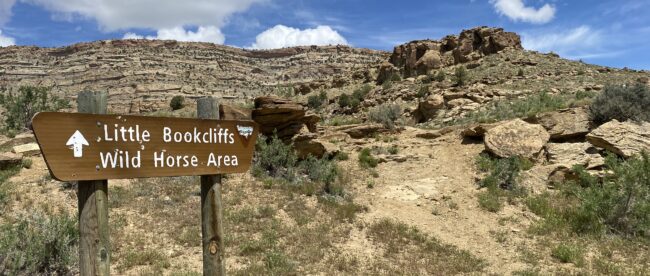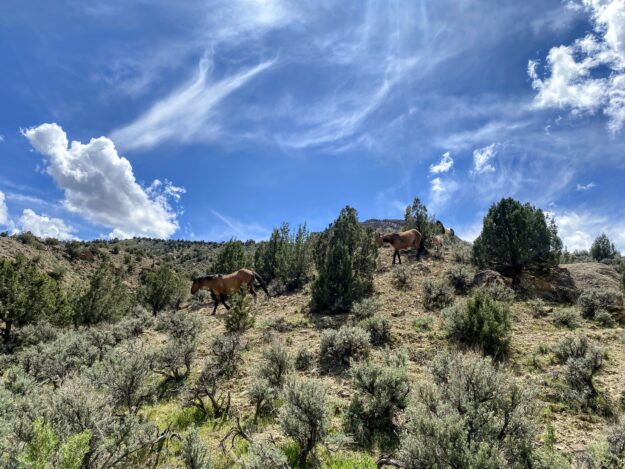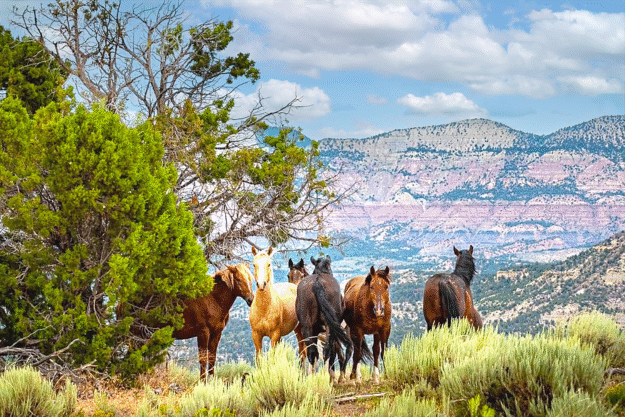Wild Horses on Colorado’s Western Slope

Get to know the Western Slope’s wild horses … and their friends
By Shauna Farnell
Mustangs have wandered Colorado’s rugged terrain for hundreds of years; you can help take care of them and even take one home
Although Colorado’s abundance and variety of wildlife is widely recognized, the wild horses roaming the Western Slope have managed to stay relatively off the radar. The local nonprofit group that has helped keep these horses alive and thriving for decades has operated in an even quieter corner.
“I love wild horses. They’re just special,” says Friends of the Mustangs (FOM) President Judy Cady. “They deserve the right to be there as much as any other animal. There are just a few of us trying to protect them.”
Working with the Bureau of Land Management (BLM), Friends of the Mustangs oversee the care of the Little Book Cliff herd, a group of horses wandering the 36,000 acres of rugged, mountainous terrain north of Palisade.

Designated in 1971 under the Wild Free-Roaming Horses and Burros Act spearheaded by animal welfare advocate “Wild Horse Annie” (Velma Bronn Johnston), Little Book Cliffs is one of only three protected wild horse ranges in the United States.
The Little Book Cliffs horses have allegedly inhabited this area since the 16th Century, descended from the steeds of indigenous tribes and Spanish colonists. The beautiful creatures represent a mix of breeds and bear every imaginable color, shape and size – palominos, red roans, appaloosas, blacks, paints, bays and sorrels. They travel in bands, some in pairs, others in family groups with young foals.
“They’re like mountain goats,” Cady says. “They’re the most sure-footed horses you’ll ever see.”

Cady, a lifelong equestrian and horse lover, became involved with the mustangs when she and her husband built a home in the area about 38 years ago.
“It just happened that the neighbor had some mustangs for sale. They weren’t broke, but they were tame,” Cady says. “My sister and I bought them. A little black mare turned out to be amazing. I started riding her. I couldn’t’ believe how much fun that was.”
Cady named the horse Beauty. She was the first of numerous mustangs Cady would personally acquire.
Population control
Like many wild animal species, mustangs often face the issue of overpopulation, the herd growing to the point where there are not enough natural resources available to sustain it. In addition to maintaining fencing, supplying and filling water tanks, FOM volunteers help helping administer birth control and facilitate adoption events when the herd becomes too large.
Last year, the Little Book Cliffs mustang population had swelled to about 230 and 100 horses were removed for adoption. Cady says the maximum number the range can support is 150. Although the State of Colorado and BLM supplies the birth control darts and designates specific horses for adoption, the process doesn’t always go as planned.
“There’s no way you can catch them all,” she says. “To get the full hundred last year, they had to take some off they weren’t planning to. They took off quite a few older horses.”
The older horses are often relocated to the Wild Horse Refuge north of Little Book Cliffs in the more remote area of Sand Wash Basin. It’s the younger animals that are typically selected for adoption.
However, animal lovers beg the question of how wild horses adjust to suddenly being placed in a domestic environment after living free for any number of years.
‘From wild to mild’
“These faithful animals create a strong bond with their new owners,” a BLM representative explains in a video of the organization’s Wild Horse and Burro Program. “Prior to arriving at their new home, they had to find a way to exist on their own. No one brought them a bucket of feed or fresh water. Now with someone to care for them, they show sincere loyalty and compassion. It is a long journey from wild to mild, but these intelligent and hearty wild animals offer their hearts and allow us to train them.”
Cady can attest to the mustangs’ adaptability and loyalty.
“Horses pretty much live in the moment,” Cady says. “They get used to stuff quickly.”
As evidence, she describes another of her favorites.
“The first adoption I got through Friends of the Mustangs was Bill. He was my big buddy, just super gentle,” she says. “I remember one time a cop came to my house and asked, do those wild mustangs ever calm down? I went outside and sat on Bill. I’d just let him eat. He never ran off. One time he went right over to the horse trailer and loaded himself.”
Cady shares another story in which she and Bill were trail riding and had to climb an extremely steep, muddy slope. She dismounted and held Bill’s tail as he pulled her to safety. On another occasion she and Bill were on a hike with her black lab when the dog’s legs gave out. Cady carried the dog on Bill’s back as the reins hung free. Her mustang Beauty, who her son rode when he was very young, frequently led her out of the dark canyon at night when Cady had lost sight of the trail.
“Bill and Beauty, they were solid gold,” Cady says. “I always trusted them to get me out of predicaments. They were always willing and knew their jobs.”
Like all horses, mustangs each have a distinctive personality. Some are willing and gentle while others are stubborn and standoffish.
Cady has embraced the distinctive character of every mustang she’s adopted and looks forward to getting to those still to come.
“I got addicted to it. Seeing wild horses, I always have my favorites. This mare I’ve got now, she’s a curious one, really funny and smart,” she says. “The one I want is a red roan, a stud with a big, thick neck. When I saw his picture, I was like, I need that guy. I hope they let me adopt him.”
Adopt a mustang
The next wild horse and burro adoption is scheduled for June 26 to 28 at Grand Junction Fairgrounds. Bidding starts at $125. For more information, visit friendsofthemustangs.org/team-4.
Become a Friend of the Mustangs
The volunteer group can use all the help it can get, even if it’s just a few hours per year. Stay updated on wild horse news by becoming a member for $10 a year. Friendsofthemustangs.org.
How to see the wild horses
About 110 wild horses currently roam the Little Book Cliffs range. The easiest way to get there is from Coal Canyon. From Interstate 70, take the Cameo exit (46 ), east of Palisade, cross the Colorado River and drive past the public service power plant. Stay on the main road approximately 1.5 miles to the parking area. From here, there is a dirt double track that extends past the gate for about 3 miles that is accessible by foot, horseback or mountain bike. There are also a couple of short singletracks suitable for hiking and horseback. The trail head is closed to motorized traffic from Dec. 1 to May 31. The best time to see the horses is in late winter and spring, when they come into the valley to graze.
For more Travel Ideas in Colorado’s Mountain Towns CLICK HERE
STORY SPONSOR
MTN Town Media Productions | Celebrating the Colorado mountain lifestyle for 15 Years
Copyright ©2025 MTN Town Media Productions, all rights reserved.

